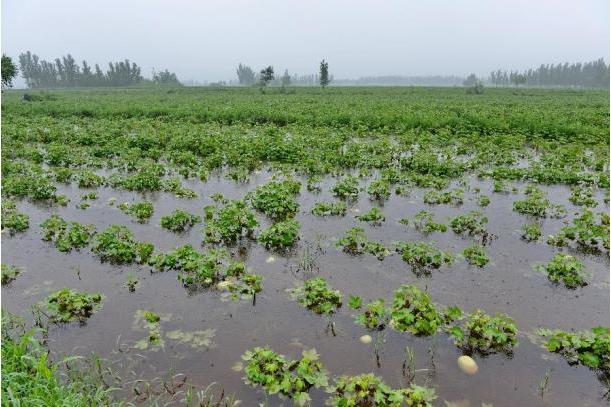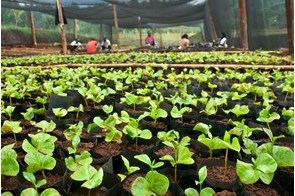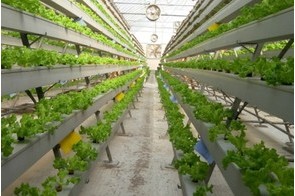The challenges and management of flooding in Africa’s agriculture

Summary
Knowing what to do before, during and after a flood can enable farmers to make better decisions.
In most parts of sub-Saharan Africa (SSA), rain is still the main source of water for growing crops. Local farmers often wait for the rainy season for planting to begin. Unfortunately, heavy rainfalls during this period result in floods, which impede agricultural activities. A report by the United Nations Food and Agriculture Organization (FAO) defines flood as “the inundation of the land surface and it is caused by seasonal accumulation of rainwater, river discharge or tidal phenomenon.”
Untarred roads and absence of good drainage systems in farming communities contribute to making it impossible for excess rainwater to be properly channeled away from swamped farmlands. Climate change is also a major driver of flooding by causing water levels to rise and increasing precipitation in different locations.
My herbs farm in Lagelu Local Government Area of Oyo State in Nigeria and the food crop farms owned by other farmers in the community are not spared the effects of excessive downpour. It is almost impossible to work in our farms when there is flooding.
The roads that lead to the farms are usually a disaster after several consecutive days of rainfall as the dirt roads become very muddy, sticky and waterlogged. Farm workers often have a hard time plying the roads. Oftentimes, some parts of the farms could be completely inundated by floodwater.
These challenges faced by farmers year in, year out, have implications for agricultural output. Flooding does not only affect farm workers; it also takes a toll on field crops, animal production and eventually food security. Despite knowing the importance of food security for their countries and communities, governments at different levels in SSA have not given enough attention to the need to mitigate the impact of flooding.
Flooding destroys crops; it delays and reduces harvest significantly. For crops to thrive, optimal conditions for growth are required. Excess water from heavy precipitation or overflowing rivers causes excessive dampening of the soil, thereby decreasing the soil’s oxygen level, which leads to poor growth and low yield. Waterlogged soils cause root diseases in crop plants. Crops that survive the floods could also be rife with diseases.
In May, thousands of acres of crops were destroyed by flash floods in Kenya. Flooding in Uganda, Rwanda, Kenya, Ethiopia, Somalia and some other parts of SSA has made hundreds of people homeless and killed many others, in addition to washing away crops.
Flooding has after-effects on soil structure, causing deterioration in the quality of crops grown on the soil in the aftermath of flooding. In addition to loss of topsoil, soil nitrogen is also diminished. Nitrogen is an important component of chlorophyll, which is responsible for the green pigment of plants. Nitrogen is also required for vibrant growth and formation of nutrient-dense plants.
When nitrogen is depleted, leaves of plants turn pale green or yellow; flowering and fruiting are delayed or even become unattainable as affected plants are unable to reach maturity. Protein, carbohydrate and other nutrients are reduced as well. Reduction in plant protein can result into stunted growth and then death if favourable conditions are not restored.
Like crops, flooding is inimical for livestock and poultry birds, too. Accumulation of water on land surface causes horrendous injuries on livestock and also loss of farm animals. The animals that survive a flood occurrence are often exposed to diseases and other health issues, including pneumonia and mastitis. Foot rot, heel canker, and ulcer are some of the foot infections that farm animals experience after staying in flood and muddy water.
The stress takes a toll on both farmers and their animals, thereby reducing overall productivity and causing economic losses. Therefore, measures must be taken to ensure adequate vaccination and protection for animals before and after a flood.
Extreme flooding takes a toll on aquatic lives as well. As water quality is compromised due to contamination of water bodies, it promotes transmission of disease pathogens. Many fishes, especially smaller ones are washed ashore by floodwater.
Smallholder farmers and fish processors and sellers who are mostly women experience hardship due to severe flooding events. All these adversely affect the livelihoods of farmers and the already-challenged food security system in developing countries, including in the SSA region.
It is very essential for governments to put in place flood control structures such as good drainage systems in rural areas where most farming activities take place. Furthermore, efforts should be intensified to warn people in flood-prone areas ahead of a potential flooding event. Adequate assistance should also be provided to such people to enable them to prepare for these devastating occurrences. Preparedness can help to minimize the adverse impact of floods on agriculture and food production. Other interventions should also be provided to support smallholders’ whose livelihoods are terribly affected by floods.
Apart from the rise in groundwater tables caused by accumulation of rainwater, which then causes rivers banks to spill over; clogging of rivers and drainage channels by debris and solid wastes hinders accumulated water from draining out. Environmental cleanliness and proper disposal of refuse should be enforced and maintained for easy run-off of rainwater to prevent flooding.
But because of instances where there are breaches on flood control structures as we have seen in many countries outside of SSA that experience seasonal floods, it is also necessary to develop and adapt improved systems that are resilient to and can accommodate floodwaters, especially in areas that are regularly flooded. The aim would be to ensure that farming communities in these countries are able to reduce productions losses.
For example, a sophisticated network of deep canals, channels and large dams like those that have helped in flood control in Thailand could be adopted in SSA’s flood-prone areas. Seasonal water levels can be controlled to a great extent using such a system.
Cultivars – or cultivated varieties of plants that have been produced by selective breeding and are imbued with specific traits – can also be introduced into new cropping patterns in flood-prone areas. Countries like Thailand and Vietnam have developed modern cultivars of rice, maize and sesame, for instance, to mitigate the impact of floods. Innovative flood control techniques in those countries and elsewhere have also limited the impact of floods on fish production.
Effective farming systems in countries and communities that are greatly affected by floods should be adapted by farmers to avoid worsening malnutrition and poverty in SSA. For instance, after a flood, it is essential to carry out certain measures to revitalize the soil. These include the removal of barriers to crop production such as sediments and debris that cannot be tilled into the soil. Also, cover crops can be planted to remediate the soil to improve the level of organic matter, reduce the impact of erosion and stimulate the activity of beneficial microbes, especially symbiotic fungi in the soil.
In addition, risk management agencies and insurance plans should be established and well communicated to farmers to provide the much-needed help. This will alleviate suffering during and after natural disasters, including floods. Crop diversification, weather and financial insurance are useful climate adaptation strategies and risk management tools that can help to minimize the unfavourable consequences of climate change. Farmers need to understand their farming environment to be able to prepare ahead and manage unfavourable conditions effectively. Let’s not forget that agricultural risks also include low rainfall, drought, outbreak of pests and diseases, as well as absence of farming equipment, machines and spare parts.
The need for agricultural extension workers, emergency personnel and alternatives for rural dwellers, especially farmers, to assist them during seasonal floods cannot be overemphasized. Extension workers should be able to help farmers recognize situations that can hinder their productivity. Knowing what to do before, during and after a flood can enable farmers to make better decisions and improve their ability to manage agricultural risks.
For example, fish farmers could be assisted with the technology and knowhow to automatically discharge excess water from their ponds to avoid destruction of the ponds and loss of fish and income.
Building capacity to respond more effectively to flood is pivotal to reducing the risks and impact of flooding on food production across sub-Saharan Africa. Anticipating potential seasonal problems to food production, processing and distribution with adequate plans before they occur can greatly limit their detrimental effects. Scouting around for solutions to problems caused by unfavourable weather conditions after the problems have occurred is not a good method of managing agricultural risks.
Financial Nigeria Columnist, Mojisola Karigidi, is a Nigerian biochemist and the founder and product developer at Moepelorse Bio Resources. She is also a Global Innovation Through Science and Technology (GIST) awardee, and an Aspen New Voices fellow.
Related
-
Uganda's Grainpulse receives $11 million from IFC to support farmers
The investment will enable Grainpulse to support its expansion and increase food production in Uganda.
-
Modern sustainable farming techniques
We must not forget that over 60 million African children under five years are not growing properly.
-
Strategies to minimise food waste and protect the environment
When a glass of milk is poured down the sink, around 255 litres of water is wasted.










